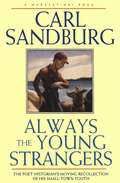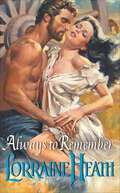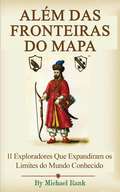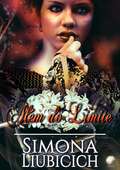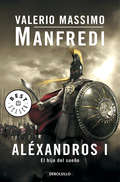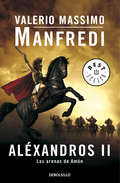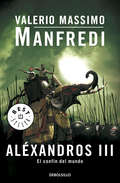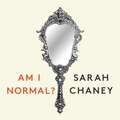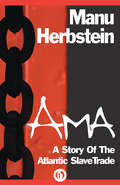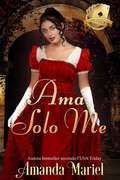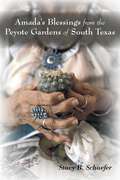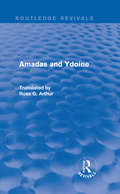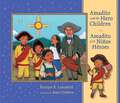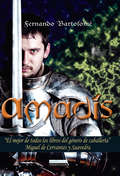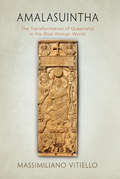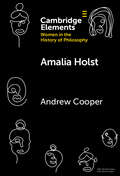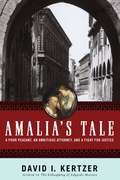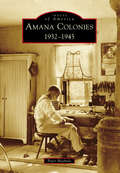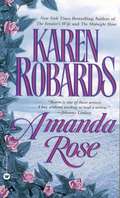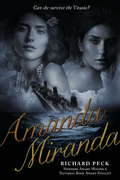- Table View
- List View
Always the Young Strangers: The Poet Historians Moving Recollection of His Small Town Youth
by Carl SandburgThe Pulitzer Prize–winning poet and historian recalls his midwestern boyhood in this classic memoir. Born in a tiny cottage in Galesburg, Illinois, in 1878, Carl Sandburg grew with America. As a boy he left school at the age of thirteen to embark on a life of work—driving a milk wagon and serving as a hotel porter, a bricklayer, and a farm laborer before eventually finding his place in the world of literature. In Always the Young Strangers, Sandburg delivers a nostalgic view of small-town life around the turn of the twentieth century and an invaluable perspective on American history.
Always to Remember
by Lorraine Heath“With its unconventional, heart-wrenching hero,” this historical romance from a New York Times bestseller “plays on every emotion . . . and, ultimately, love” (Publishers Weekly).Branded a traitor and imprisoned for refusing to fight for the Confederacy, Clayton Holland returns home to Cedar Grove, only to be spurned by the townspeople. Everyone except Meg Warner, who commissions Clayton Holland to construct a memorial for Cedar Grove’s fallen heroes. As Meg watchs him work, she lets get of her own grief as she sees a strength in Clayton that draws her closer to him.
Always, My Love
by Dorothy FletcherAs Crimson Romance celebrates its first anniversary, we honor those pioneers who helped shape the direction of romance novels for all of us. Suspense, mystery, paranormal activity, and love - always love - have been the cornerstone of the genre since the early 1970s. Now we have updated the covers to these classics - but not the words - and reissued these timeless reads to let you relive the thrill of discovering a world of romance all over again.A Love TriangleFor almost two years, Iris Easton has told herself that falling in love is dangerous because it can break your heart. After all, hadn’t it happened to her?So, when she arrives in Paris with her recently widowed Aunt Louisa and meets the magnetically handsome Frenchman Paul Chandon, it is only natural that Iris gives him the cold shoulder. But with her aunt’s encouragement and Paul’s charming persistence, he quickly becomes their companion.Then it dawns on Iris: Is it Louisa that Paul is attracted to? Louisa is a beautiful woman, but she is so much older. Perhaps Paul is a fortune hunter after her aunt’s money.Whatever the reason, Iris has to know the truth. And as she abandons the jealousy and pride, she discovers the true passions of her heart to learn that l’amour is forever.Sensuality Level: Behind Closed Doors
Além das Fronteiras do Mapa: 11 Exploradores Que Expandiram os Limites do Mundo Conhecido
by Michael Rank Makoto YamamotoDo aclamado autor do livro Os Maiores Generais da História, esta nova e emocionante obra narra os maiores exploradores da história e como suas descobertas formaram o mundo moderno. Seja Rabban Bar Sauma, o monge chinês do século 13 enviado pelos mongóis ao Ocidente para formar uma aliança militar contra o Islã; Marco Polo, que abriu uma janela do Oriente à Europa; ou o capitão James Cook, cujas viagens marítimas criaram a economia global do século 21, cada um desses exploradores tiveram um impacto indelével na sociedade moderna. Este livro abrange os 11 maiores exploradores da história. Alguns viajaram com fins religiosos - caso de Ibn Battuta, que viajou do norte da África à Indonésia em 1300, visitando os locais de peregrinação islâmica entre e se tornando conselheiro de mais de 30 chefes de Estado. Outros viajaram com fins lucrativos, como Fernão de Magalhães, que queria consolidar a participação da Espanha no comércio de especiarias. Houve quem viajasse pela pura emoção da aventura - caso do explorador vitoriano Richard Francis Burton, que aprendeu 29 línguas, foi disfarçado como muçulmano em uma peregrinação a Meca e escreveu 50 livros sobre temas que vão desde a tradução do Kama Sutra até um manual de exercícios para baioneta. E ainda há aqueles que viajaram pelo amor à descoberta, como Ernest Shackleton, que liderou duas dezenas de homens até os confins do mundo, na tentativa de atravessar a Antártida a pé. Seja qual for o motivo, esses exploradores ainda hoje nos inspiram a ultrapassar os limites da realização humana - e descobrir algo sobre nós mesmos no processo.
Além do limite
by Simona LiubicichSan Francisco, 1905 Para Philippa Green, seu trabalho de investigadora é tudo, sua independência como mulher é tão importante quanto o ar que respira. Apesar da segurança aparente, o único homem que amou de verdade quebrou seu coração: Clive Anderson, capitão do Departamento de Investigações de São Francisco. Agora, uma série de homicídios a obriga a trabalhar lado a lado com ele e Phil terá que lutar contra si mesma para recusar a paixão que a devora, enquanto um assassino astuto anda na sombra a procura de suas vítimas. Ela pode estar na sua mira...
Aléxandros I: El hijo del sueño
by Valerio Massimo ManfrediPrimer volumen de trilogía de Manfredi dedicada a Alejandro Magno. Nadie puede permanecer indiferente ante la belleza de Alejandro, ni ante la grandiosidad de su imperio, que se extendió desde el Danubio hasta el Indo. Un hombre considerado como un dios por sus contemporáneos, de ardientes sueños y violentas pasiones, que le consumieron hasta finalmente destruirle. Su vida transcurrió en un mundo de leyenda. Esta es su historia. Reseña:«En esta excelente novela, Manfredi ha volcado todo su saber histórico y cuanta pasión era capaz de derrochar.»El Mundo
Aléxandros II: Las arenas de Amón
by Valerio Massimo ManfrediSegundo libro de la trilogía Aléxandros, en la que el Valerio Massimo Manfredi nos relata la vida de Alejandro Magno, uno de los mayores héroes militares de la antigüedad. «La conquista de Asia es la siguiente hazaña que se propone Alejandro...» En Anatolia corta el nudo gordiano; dicen que quien lo deshaga dominará el confín del mundo. Finalmente, él y sus hombres derrotan al poderoso Darío, rey de los persas. Así, las tropas victoriosas de Alejandro avanzan hasta Egipto, donde el oráculo de Amón le revela su origen divino y su destino de gloria inmortal. Las Arenas de Amón es una novela llena de trepidante acción, donde hay cabida para las luchas, estrategias militares, tramas, altas traiciones# e incluso para el amor. Reseñas:«Entretenimiento y erudición.»Qué Leer
Aléxandros III: El confín del mundo
by Valerio Massimo ManfrediAlejandro aspira a convertir el mundo conocido en una sola nación bajo su mando, pero pocos comparten su sueño... El ejército macedonio se adentra en Babilonia y asesta el golpe final al secular imperio persa. Alejandro aspira a convertir el mundo conocido en una sola nación bajo su mando, pero pocos comparten su sueño. Se urden conjuras, y el rey se ve arrastrado hacia una vorágine de violencia. Solo el amor de Roxana puede aliviar su soledad. Ella le infundirá el valor necesario para llegar a la India misteriosa y luego la fuerza para buscar el camino de retorno. «Hay escenas en los tres volúmenes de Aléxandros que te dejan prácticamente sin respiración.»Qué Leer
Am I Normal?: The 200-Year Search for Normal People (and Why They Don’t Exist)
by Sarah ChaneyA deep dive into the strange science of the 'Normal', and the roots of an anxiety-ridden modern obsessionBefore the nineteenth century, the term normal was rarely ever associated with human behaviour. Normal was a term used in maths, for right angles. People weren't normal; triangles were.But from the 1830s, this branch of science really took off across Europe and North America, with a proliferation of IQ tests, sex studies, a census of hallucinations - even a UK beauty map (which concluded the women in Aberdeen were "the most repellent"). This book tells the surprising history how the very notion of the normal came about, how it shaped us all, often while entrenching oppressive values. Sarah Chaney looks at why we're still asking the internet: Do I have a normal body? Is my sex life normal? Are my kids normal? And along the way, she challenges why we ever thought it might be a desirable thing to be.
Ama
by Manu HerbsteinWinner of the 2002 Commonwealth Prize for Best First Book. Thrust into a foreign land, passed from owner to owner, stripped of her identity. This is the life of Nandzi, who was given the name Ama, a name strange to her and her tribal culture. A life of struggle and resignation, bondage and freedom, passion and indifference, intense love and remorseless hate. Though forced into desperation, Ama never lets her soul be consumed by fear. While the stories of individual slaves have been blurred into one mass, Ama's story personifies the experience of eighteenth-century Africans in an unforgettable way. Her entrancing story of defiance and spiritual fire starts from the day she is brutally seized, raped, and enslaved, and ends with her breathing the pure air of freedom. AMA is a deeply engrossing and colorful novel, packed with violence, sex, and action. The resiliency of her spirit will grip readers from the first page to the last of Manu Herbstein's spellbinding novel.
Ama Solo Me
by Ilaria Grandi Myeditor Amanda MarielNata nobildonna ma cresciuta come un maschiaccio, Lady Narissa si muove con disinvoltura tra l'élite di Londra e i suoi membri capricciosi. Non avendo mai accettato il ruolo di figlia di un conte, ha aperto una sala da gioco clandestina per sole donne dedicata alle signore dell'alta società ed è determinata a seguire le orme del padre. Seth Blakley, duca di Blackmore, non riesce a tenere a freno la sua vivace sorella. Il suo unico desiderio è vederla sistemata con un buon matrimonio prima che si ritrovi irreparabilmente rovinata. Non avrebbe mai immaginato in cosa sarebbe incappato seguendola nella sala da gioco clandestina di Lady Narissa. Seth è affascinato da Lady Narissa e farà di tutto per conoscere meglio quella donna bellissima e anticonvenzionale, seppure ella sembri non desiderare altro che il duca la lasci in pace e dimentichi l'esistenza del suo club. Ma la passione li unirà e farà scoprire loro che l'amore è più importante dei vincoli e degli accordi che minacciano di allontanarli.
Amada Senhora Doroês
by Heather SnowDepois de quase cinco anos de tormento nas mãos das piores fofocas da sociedade, Lady Phoebe Anson finalmente a faz escapar, seguindo seu sonho para autorar textos botânicos - mesmo que ela deva fingir ser um homem para fazê-lo. Quando seu único amigo, Lord Malcolm Gray, acontece sobre ela na Feira Frost de 1814 e descobre seu enredo, Phoebe se recusa a deixá-lo arruinar sua vida - novamente. Mas Malcolm não é o jovem tolo que ele já foi, embora ele saiba que ele tem muito para expiar onde Phoebe está preocupado. E ele não tem intenção de deixar seu dervixe fugir desta vez ...
Amada's Blessings from the Peyote Gardens of South Texas
by Stacy B. SchaeferAmada Cardenas, a Mexican American woman from the borderlands of South Texas, played a pivotal role in the little-known history of the peyote trade. She and her husband were the first federally licensed peyote dealers. They began harvesting and selling the sacramental plant to followers of the Native American Church (NAC) in the 1930s, and after her husband&’s death in the late 1960s Mrs. Cardenas continued to befriend and help generations of NAC members until her death in 2005, just short of her 101st birthday. Author Stacy B. Schaefer, a close friend of Amada, spent thirteen years doing fieldwork with this remarkable woman. Her book weaves together the geography, biology, history, cultures, and religions that created the unique life of Mrs. Cardenas and the people she knew. Schaefer includes their words to help tell the story of how Mexican Americans, Tejanos, gringos, Native Americans, and others were touched and inspired by Amada Cardenas&’s embodiment of the core NAC values: faith, hope, love, and charity.
Amadas and Ydoine (Routledge Revivals)
by Ross G. ArthurThis translation, first published in 1993, presents a little-known medieval romance to readers who do not know Old French, or who are generally unfamiliar with the literature of the Middle Ages. Probably composed between 1190 and 1220, the major interest of Amadas and Ydoine to modern readers is that its basic structure is unflinchingly conventional, its plot is predictable yet charming, and its social and moral attitudes reflect the context in which it was produced. The poet explores how love, chivalry and martial prowess can translate a would-be knight into a powerful lord. Its purpose is largely that of wish-fulfilment for young men, and as such it is highly indicative of the ethos surrounding marriage that prevailed in medieval French society.
Amadito and the Hero Children: Amadito y los Niños Héroes (Pasó Por Aquí Series on the Nuevomexicano Literary Heritage)
by Enrique R. LamadridRecent health scares such as H1N1 influenza have exposed children to frightening information that can be difficult to process. This thoughtful bilingual book helps them understand the abstract concept of largescale sickness and appreciate the role children play in the health of their community. It introduces young readers to a fascinating aspect of southwest history, and invites discussion of folk medicine and science, while also addressing children&’s curiosities and fears. Recounting the two most deadly epidemics to strike the Southwest—smallpox in the eighteenth and nineteenth centuries and influenza during World War I—this beautifully illustrated narrative reveals that with tragedy comes heroism, as demonstrated by the children who bravely transported the smallpox vaccine from Mexico&’s interior to New Mexico in 1805. Through the eyes of the protagonist José Amado &“Amadito&” Domínguez—a real child of the flu epidemic era who would later become Taos County&’s first nuevomexicano physician—folklorist Lamadrid weaves together culture, history, mortality, and hope into a life-affirming lesson.
Amadís (Narrativa)
by Fernando Bartolomé BenitoLas fantásticas aventuras, amores furtivos, hechizos y grandes hechos de armas del heroico caballero Amadís de Gaula,la bella princesa Helisena, sus hermanos Galaor y Floristán, la Señora Oriana y el lábil rey Lisuarte. El Amadís de Gaula(Los cuatro libros del virtuoso caballero Amadís de Gaula) es la obra maestra de la literatura medieval de aventuras en castellano y el más famoso de los llamados libros de caballerías, y tuvo un formidable éxito en toda Europa. Fue publicado por Garci Rodríguez de Montalvo a principios del siglo XVI. Miguel de Cervantes lo considera el padre de los libros de caballerías, y es la obra que le inspira a escribir Don Quijote de la Mancha. En El Quijote, el cura y el barbero salvan de la quema de libros a "Los cuatro Amadís de Gaula" porque "es el mejor de todos los libros del género de caballería. Único en su arte" . Ediciones Nowtilus publica la primera versión revisada y adaptada al castellano moderno por Fernando Bartolomé, catedrático y experto en literatura del siglo XVI. Gracias a esta fantástica novela el lector revivirá las aventuras de un bravo guerrrero de alta alcurnia y fidelidad inquebrantable a su rey, que realizó hazañas admirables dirigidas a su hermosa dama, la bella princesa Helisena.
Amalasuintha: The Transformation of Queenship in the Post-Roman World
by Massimiliano VitielloIn this book, Massimiliano Vitiello situates the life and career of the Ostrogothic queen Amalasuintha (c. 494/5-535), daughter of Theoderic the Great, in the context of the transitional time, after the fall of Rome, during which new dynastic regimes were experimenting with various forms of political legitimation. A member of the Gothic elite raised in the Romanized palace of Ravenna, Amalasuintha married her father's chosen successor and was set to become a traditional Gothic queen—a helpmate and advisor to her husband, the Visigothic prince Eutharic—with no formal political role of her own. But her early widowhood and the subsequent death of her father threw her into a position unprecedented in the Gothic world: a regent mother who assumed control of the government.During her regency, Amalasuintha clashed with a conservative Gothic aristocracy who resisted her leadership, garnered support among her Roman and pro-Roman subjects, defended Italy from the ambitions of other kings, and negotiated the expansionistic designs of Justinian and Theodora. When her son died unexpectedly at a young age, she undertook her most dangerous political enterprise: forming an unmarried coregency with her cousin, Theodahad, whom she raised to the throne. His final betrayal would cost Amalasuintha her rule and her life.Vitiello argues that Amalasuintha's story reveals a key phase in the transformation of queenship in late antiquity and the early Middle Ages, a time in which royal women slowly began exercising political power. Assessing the ancient sources for Amalasuintha's biography, Cassiodorus, Procopius, Gregory of Tours, and Jordanes, Vitiello demonstrates the ways in which her life and public image show the influence of late Roman and Byzantine imperial models on the formation of female political power in the post-Roman world.
Amalia Holst (Elements on Women in the History of Philosophy)
by Andrew CooperAmalia Holst's trailblazing book On the Vocation of Woman to Higher Intellectual Education (1802) dropped a bomb on the German speaking states-a bomb that failed to detonate. In one of the first works of philosophy in German published under a woman's name, Holst declares that it is time a member of the female sex spoke out about the plight of women in Germany. Despite her bold attempt to ignite a new movement of women's education, her book was harshly reviewed by male critics and thrust into obscurity. This Element presents the first comprehensive study of Holst's writings, unearthing their striking contribution to philosophy's growing awareness of the social conditions of human freedom. The force of her argument, and the difficulties she encountered, reveal the ambiguous character of the German Enlightenment and prompt us to reconsider what can be salvaged from it.
Amalias Tale
by David I. KertzerThis quintessential David-and-Goliath saga tells the story of a wholly unexpected triumph of the poor against the rich and of a crusading city attorney who fought on behalf of an impoverished peasant. Amalia Bagnacavalli, an illiterate young peasant from the mountains near Bologna, is forced by poverty to take in a child from the city’s foundling home to wet-nurse. When Amalia contracts syphilis from the sickly and malformed baby given to her, the city fathers callously dismiss her pleas for treatment and restitution. Bewildered and frightened, she seeks out Augusto Barbieri, an ambitious attorney looking to make a name for himself. He takes up Amalia’s cause, fighting the case for years through the Italian courts before winning an unprecedented and stunning victory for his by now broken client. The unforgettable story of a landmark struggle for basic human rights, Amalia’s Tale is the moving drama of a rural woman whose life was ruined and the man from the city who would not stop -- or so it seemed -- until he had seen justice done.
Amana Colonies: 1932-1945 (Images of America)
by Peter HoehnleThe Amana Colonies were founded by members of the Community of True Inspiration, a Pietist sect that originated in southwest Germany in 1714. Beginning in 1842, members of the sect migrated to New York and founded the Eben-Ezer Society, in which land, shops, and homes were owned communally. Members worked at assigned jobs, attended 11 church services each week, and received food, clothing, and shelter. Beginning in 1855, the community relocated to a 26,000-acre tract in eastern Iowa, where they founded the seven Amana villages, each with its own church, school, general store, craft shop, and barns. A disastrous fire, economic downturns, and a growing dissatisfaction with communal life led the members to vote to reorganize as a separate business and church organization in 1932. Images of America: Amana Colonies: 1932-1945 examines a time when the Amana people worked to preserve aspects of their traditional religious and cultural life while, simultaneously, learning to embrace American life and the waves of people who visited these unique villages in growing numbers.
Amanda Rose
by Karen RobardsNew York Times bestselling author Karen Robards deliciously mixes adventure and romance in her beloved tale of a buccaneer and a convent girl--a romance so magnificent it will make your pulse pound and your heart rejoice. Orphaned heiress Lady Amanda Rose Culver wanted to run from the injured man she found on the rocky shore near her convent school. But his hard-muscled hand stopped her even before she saw the pain and longing in his eyes. And she trembled, not with fear, but with a desire to believe in his story, his innocence, his passion. New World privateer Matt Grayson, unjustly accused of murder by the British Crown, has narrowly escaped hanging. Now his freedom depends on winning this beautiful girl's co-operation so he can sail back to New Orleans. He never meant to hold her captive on his ship. He never meant to fall in love. . . .
Amanda/Miranda
by Richard PeckIntrigue, romance, and scheming aboard the Titanic This updated edition of the popular Richard Peck novel, available in time to commemorate the anniversary of the Titanic's fateful voyage in 1912, starts with a chilling prophecy. When Miranda begins her position as maid-servant to the glamorous and selfish Amanda Whitwell, Amanda wastes no time in using Miranda to suit her own cruel purposes. Miranda becomes the lynchpin to a plot that Amanda devises to marry an American who can maintain her lavish lifestyle, but also keeps the rogue she loves close at hand. However, destiny intervenes, and they board the ill-fated Titanic. This story has all of the romance, glamour, intrigue, and tragedy of the Titanic but ends, satisfyingly, with redemption and forgiveness.
Amandine: A Novel
by Marlena De BlasiThe acclaimed author of such memoirs as "A Thousand Days in Venice" brings her luminous prose to the world of fiction with this debut novel. Set against the backdrop of Europe as it moves toward World War II, "Amandine" follows a young orphan's journey in search of her heritage.
Amando Sarah
by Sandy RavenEla procurava aventura, ele estava fugindo do destino. Lady Sarah Halden entra clandestinamente no navio, pretendendo participar de uma competição
Amando a Pablo, odiando a Escobar: Odiando A Escobar (Vintage Espanol Ser.)
by Virginia Vallejo¡PRONTO EN LA GRAN PANTALLA!En julio de 2006 un avión de la DEA sacó a Virginia Vallejo de Colombia. Su vida estaba en peligro por haberse convertido en el testigo clave de los dos procesos criminales más importantes de la segunda mitad del siglo XX en su país: el asesinato de un candidato presidencial y el holocausto del Palacio de Justicia.Veinticinco años antes, Virginia Vallejo era la presentadora de televisión más importante de Colombia y la belleza profesional que aparecía en las portadas de las principales revistas. Cortejada por multimillonarios tradicionales, conoció en 1982 a Pablo Escobar, un misterioso político de treinta y tres años que en realidad manejaba los hilos de un mundo de riqueza inigualable en el que gran parte del incesante flujo de dinero procedente del tráfico de cocaína se canalizaba a proyectos de caridad y a las campañas de candidatos presidenciales de su elección.Este libro, una apasionada historia de amor convertida en crónica del horror y la vergüenza, describe la evolución de una de las mentes criminales más siniestras de nuestro tiempo: su capacidad de infundir terror y generar corrupción, los vínculos entre sus negocios ilícitos y varios jefes de estado, los asesinatos de candidatos presidenciales y la guerra en que sumió a su país. Amando a Pablo, odiando a Escobar es también la única visión íntima posible del legendario barón del narcotráfico, plena de glamour y espíritu de supervivencia y no exenta de humor. Virginia Vallejo narra esta historia descarnada como nadie más podría haberlo hecho.
